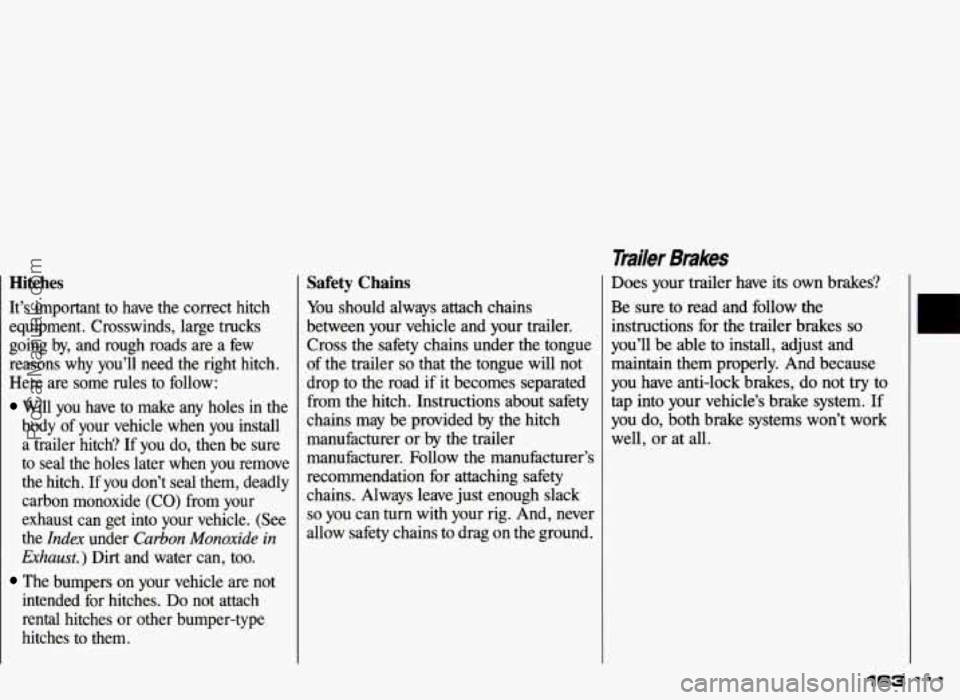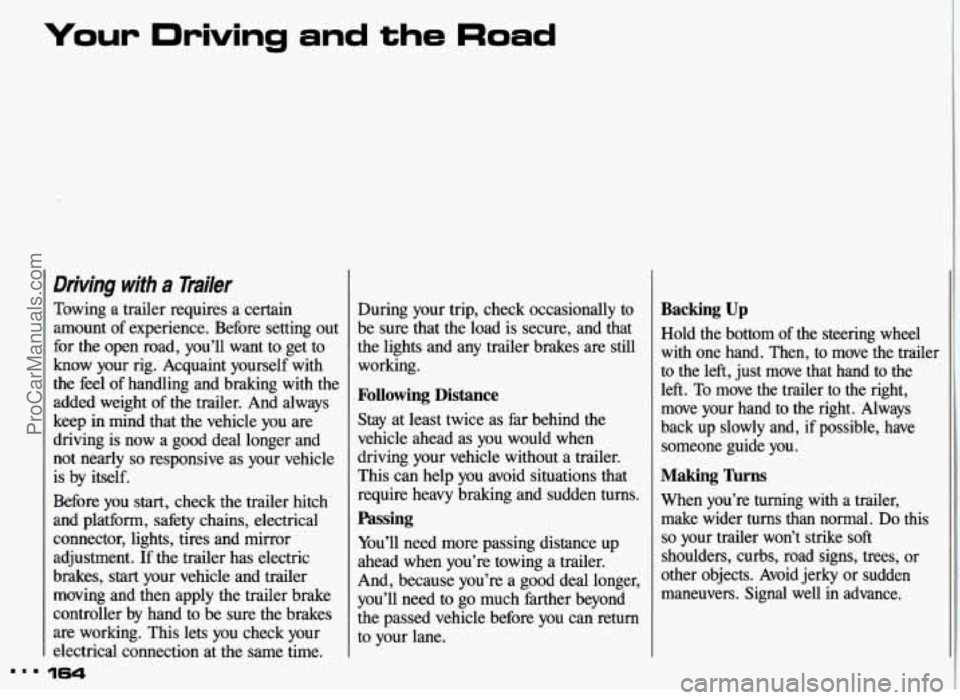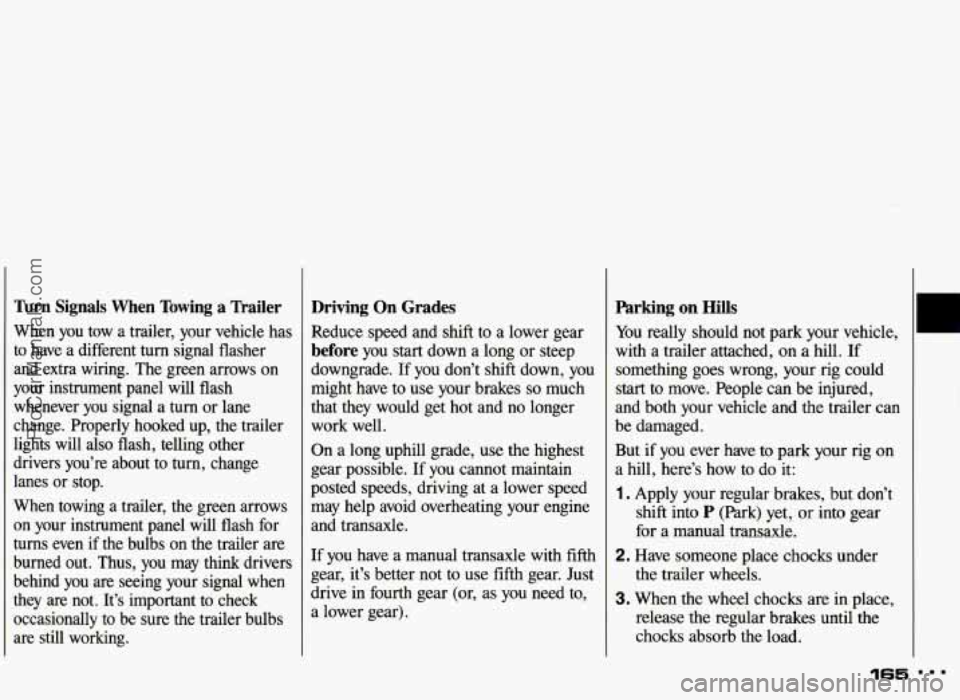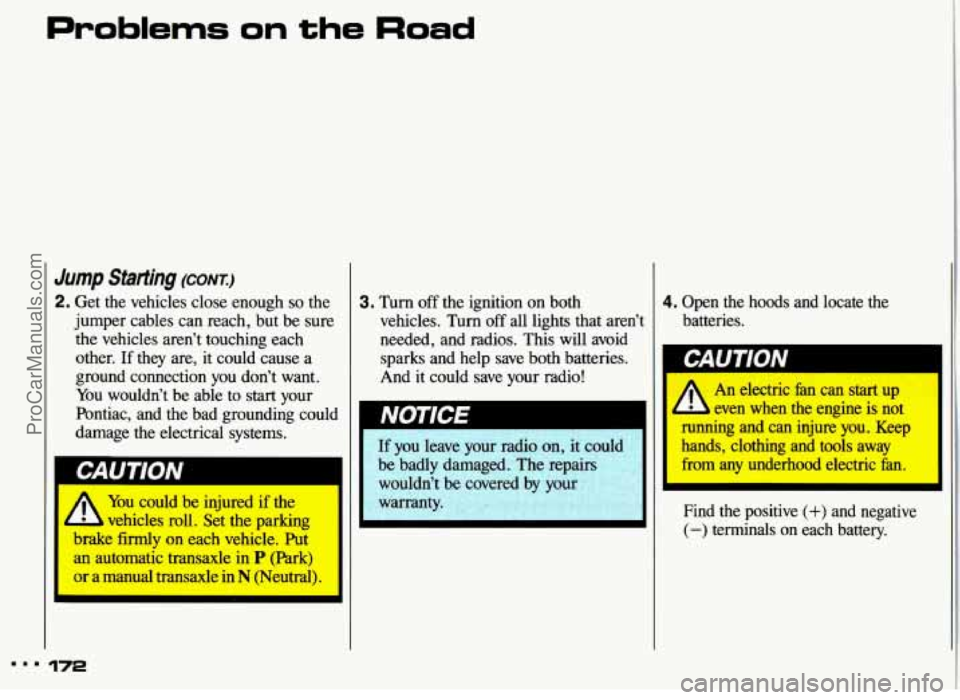1993 PONTIAC GRAND-AM brake
[x] Cancel search: brakePage 156 of 306

If you’re going uphill on a one-way
uphill,
turn the wheels to the right.
street and you’re parking on the left
If there is no curb when you’re parking
uphill on the left side
of a one-way right.
If there is no curb when you’re parking
side, your wheels should point to the
street, your wheels should
be turned to
the left:
Toque Lock (AUTOMATN: rtunsAxLq
If you are parking on a hill and you
don’t shift your transaxle into
P (Park)
properly, the weight of the vehicle may
put too much force on the parking pawl
in the transaxle. You may find it difficult
to pull the shift lever out
of P (Park).
This is called “torque lock,” To prevent
torque lock, always be sure
to shift into
P (Park) properly before you leave the
driver’s seat. To find out how, see the
Index under Shifting Into P (Park).
When you are ready to drive, move the
shift lever out
of P (Park) before you
release the parking brake.
If torque lock does occur, you may need
to have another vehicle push yours a
little uphill to take some
of the pressure
from the transaxle, so you can pull the
shift lever out of P (Park).
c
155
ProCarManuals.com
Page 158 of 306

Whatever the condition-smooth ice,
packed, blowing or loose snow-drive with caution. Accelerate gently. Try not
to break the fragile traction. If you
accelerate too fast, the drive wheels will spin and polish the surface under the
tires even more.
Your anti-lock brakes improve your
ability
to make a hard stop on a slippery
road. Even though you have the anti-
lock braking system, you’ll want to
begin stopping sooner than you would on dry pavement. See the
Idex under
1 Anti-Lock Brake System (ABS).
Allow greater following distance on
any slippery road.
Watch for slippery spots. The road
might be fine until you hit a spot that’s
covered with ice. On an otherwise
clear road, ice patches may appear in
shaded areas where the
sun can’t
reach: around clumps of trees, behind
buildings, or under bridges.
Sometimes the surface of a curve or
an overpass may remain icy when the
surrounding roads are clear. If you see
a patch
of ice ahead of you, brake
before you are on it.
Try not to brake
while you’re actually on the ice, and
avoid sudden steering maneuvers.
If You’re Caught in a Blizzard
If you are stopped by heavy snow, you
could be in a serious situation.
You
should probably stay with your vehicle
unless you know for sure that you are
near help and you can hike through the
snow. Here are some
things to do to
summon help and keep yourself and
your passengers safe:
Turn on your hazard flashers.
Tie a red cloth to your vehicle to alert
police that you’ve been stopped by the
snow.
157
ProCarManuals.com
Page 160 of 306

To help keep warm, you can get out of
the vehicle and do some fairly
vigorous exercises every half-hour or
so until help comes.
If You're Stuck in Deep Snow
This manual explains how to get the
vehicle out of deep snow without
damaging it. See the
Index under
Rocking Your Ehicle.
Towing a nailer
A
If you don't use the correct
equipment and drive properly,
you can lose control when you pull
a trailer. For example, if the trailer
is too heavy, the brakes may not
work well-or even at
all. You and
your passengers could be seriously
injured. Pull a trailer
only if you
have followed all the steps in
this
section.
I
ProCarManuals.com
Page 164 of 306

Hitches
It’s important to have the correct hitch
equipment. Crosswinds, large trucks
going by, and rough roads are a few
reasons why you’ll need the right hitch.
Here are some rules to follow:
Will you have to make any holes in the
body
of your vehicle when you install
a trailer hitch? If you do, then be sure
to seal the holes later when you remove
the hitch. If you don’t seal them, deadly
carbon monoxide (CO) from your
exhaust can get into your vehicle. (See
the
Index under Carbon Monoxide in
Exhaust.) Dirt and water can, too.
The bumpers on your vehicle are not
intended for hitches. Do not attach
rental hitches or other bumper-type
hitches to them.
Safety Chains
You should always attach chains
between your vehicle and your trailer.
Cross the safety chains under the tongue
of the trailer
so that the tongue will not
drop to the road if it becomes separated
from the hitch. Instructions about safety
chains may be provided by the hitch
manufacturer or by the trailer
manufacturer. Follow the manufacturer’s
recommendation for attaching safety
chains. Always leave just enough slack
so you can turn with your rig. And, never
allow safety chains to drag on the ground.
Trailer Brakes
Does your trailer have its own brakes?
Be sure to read and follow the
instructions for the trailer brakes
so
you’ll be able to install, adjust and
maintain them properly. And because
you have anti-lock brakes, do not try to
tap into your vehicle’s brake system. If
you do, both brake systems won’t work
well, or at all.
163 ProCarManuals.com
Page 165 of 306

Your Driving and the Road
Driving with a lbiler
Towing a trailer requires a certain
amount of experience. Before setting out
for the open road, you’ll want to get to
know your rig. Acquaint yourself with
the feel of handling and braking with the
added weight of the trailer. And always
keep
in mind that the vehicle you are
driving is now a good deal longer and
not nearly
so responsive as your vehicle
is by itself.
Before you start, check the trailer hitch
and platform, safety chains, electrical
connector, lights, tires and mirror
adjustment.
If the trailer has electric
brakes, start your vehicle and trailer
moving and then apply the trailer brake
controller by
hand to be sure the brakes
are working.
This lets you check your
electrical connection at the same time.
164
During your trip, check occasionally to
be sure that the load is secure, and that
the lights and any trailer brakes are still
working.
Following Distance
Stay at least twice as far behind the
vehicle ahead as you would when
driving your vehicle without a trailer.
This can help you avoid situations that
require heavy braking and sudden
turns.
Passing
You’ll need more passing distance up
ahead when you’re towing a trailer.
And, because you’re a good deal longer,
you’ll need to go much farther beyond
the passed vehicle before you can return
to your lane.
Backing Up
Hold the bottom of the steering wheel
with one hand. Then, to move the trailer
to the left, just move that hand to the
left.
To move the trailer to the right,
move your hand to the right. Always
back up slowly and,
if possible, have
someone guide you.
Making Turns
When you’re turning with a trailer,
make wider turns than normal.
Do this
so your trailer won’t strike soft
shoulders, curbs, road signs, trees, or
other objects. Avoid jerky
or sudden
maneuvers. Signal well in advance.
ProCarManuals.com
Page 166 of 306

Turn Signals When Towing a ’Railer
When you tow a trailer, your vehicle has
to have a different turn signal flasher
and extra wiring. The green arrows on
your instrument panel will flash
whenever you signal a
turn or lane
change. Properly hooked up, the trailer
lights will also flash, telling other drivers you’re about to turn, change
lanes or stop.
When towing a trailer, the green arrows
on your instrument panel will flash for
turns even if the bulbs on the trailer are
burned out. Thus, you may think drivers
behind you are seeing your signal when
they are not. It’s important to check occasionally to be sure the trailer bulbs
are still working.
Driving On Grades
Reduce speed and shift to a lower gear
before you start down a long or steep
downgrade. If you don’t shift down, you
might have to use your brakes
so much
that they would get hot and no longer work well.
On a long uphill grade, use the highest
gear possible. If you cannot maintain
posted speeds, driving at a lower speed
may help avoid overheating your engine
and transaxle.
If you have a manual transaxle with
fifth
gear, it’s better not to use fifth gear. Just
drive in fourth gear (or, as you need to,
a lower gear).
Parking on Hills
You really should not park your vehicle,
with a trailer attached,
on a hill. If
something goes wrong, your rig could
start to move. People can be injured,
and both your vehicle and the trailer can
be damaged.
But if you ever have to park your rig on
a hill, here’s how to do it:
1. Apply your regular brakes, but don’t
shift into
P (Park) yet, or into gear
for a manual transaxle.
2. Have someone place chocks under
the trailer wheels.
3. When the wheel chocks are in place,
release the regular brakes until the chocks absorb the load.
165 DDD
ProCarManuals.com
Page 167 of 306

Your Driving and the Road
Driving with a mailer (CONT.)
4. Reapply the regular brakes. Then
apply your parking brake, and then shift to
P (Park), or R (Reverse) for a
manual transaxle.
5. Release the regular brakes.
When You Are Ready to Leave After
Parking on a
Hill
1. Apply your regular brakes and hold
the pedal down while you:
Start your engine;
Shift into a gear; and
Release the parking brake.
2. Let up on the brake pedal.
3. Drive slowly until the trailer is clear
4. Stop and have someone pick up and
of the chocks.
store the chocks.
Maintenance When Tmiler Towing
Your vehicle will need service more
often when you’re pulling a trailer. See
the Maintenance Schedule for more on
this. Things that are especially important in trailer operation are
automatic transaxle fluid (don’t overfiil),
engine oil, belts, cooling system, and
brake adjustment. Each
of these is
covered
in this manual, and the Ida
will help you find them quickly. If
you’re trailering, it’s a good idea to
review these sections before you
start
your trip.
Check periodically to see that all hitch
nuts and bolts are tight.
m.. 166
ProCarManuals.com
Page 173 of 306

Jump Starting (CONTJ
2. Get the vehicles close enough so the
jumper cables can reach, but be sure
the vehicles aren’t touching each
other.
If they are, it could cause a
ground connection you don’t want.
You wouldn’t be able to
start your
Pontiac, and the bad grounding could
damage the electrical systems.
I; vehicles roll. Set the parking
brake
firmly on each vehicle. Put
an automatic transaxle in
P (Park)
or a manual transaxle in
N (Neutral). I I
3. Turn off the ignition on both
vehicles. Turn
off all lights that aren’t
needed, and radios.
This will avoid
sparks and help save both batteries.
And it could save your radio!
. 8. r ~
I If you leave your radio on, it could
4. Open the hoods and locate the batteries.
An electric fan can start up
e engine is not
running and can injure you. Keep
hands, clothing and tools away
from any underhood electric fan.
Find the positive (+) and negative
(-) terminals on each battery,
I.. 172
ProCarManuals.com